Chelsea F.C.
Chelsea Football Club are an English professional football club based in Fulham, London. Founded in 1905, they compete in the Premier League, the top division of English football. Chelsea are among England's most successful clubs; they have been league champions six times, and won over thirty competitive honours - including six European trophies. Their home ground is Stamford Bridge.[4]
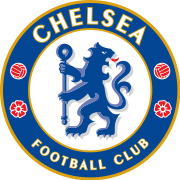 | ||||
| Full name | Chelsea Football Club | |||
|---|---|---|---|---|
| Nickname(s) | The Blues, The Pensioners[1] | |||
| Short name | CFC, CHE | |||
| Founded | 10 March 1905[2] | |||
| Ground | Stamford Bridge | |||
| Capacity | 40,834[3] | |||
| Coordinates | 51°28′54″N 0°11′28″W | |||
| Owner | Roman Abramovich | |||
| Chairman | Bruce Buck | |||
| Head coach | Frank Lampard | |||
| League | Premier League | |||
| 2018–19 | Premier League, 3rd of 20 | |||
| Website | Club website | |||
| ||||
Chelsea won their first major honour, the League Championship, in 1955. They won the FA Cup for the first time in 1970 and their first European honour, the UEFA Cup Winners' Cup, in 1971. After a period of decline in the late 1970s and 1980s, the club enjoyed a revival in the 1990s and had more success in cup competitions. The past two decades have been the most successful in Chelsea's history: they won five of their six league titles and the UEFA Champions League during this period.[5] Chelsea are one of five clubs to have won all three of UEFA's main club competitions, and the only London club to have won the Champions League.
Chelsea's home kit colours are royal blue shirts and shorts with white socks. The club's crest features a ceremonial lion rampant regardant holding a staff.[6] The club have rivalries with neighbouring teams Arsenal and Tottenham Hotspur, and a historic rivalry with Leeds United. Based on attendance figures, the club have the sixth-largest fanbase in England.[7] In terms of club value, Chelsea are the sixth most valuable football club in the world, worth £2.13 billion ($2.576 billion), and are the eighth highest-earning football club in the world, with earnings of over €428 million in the 2017–18 season.[8][9] Since 2003, Chelsea have been owned by Russian billionaire Roman Abramovich.[10]
History

In 1904, Gus Mears acquired the Stamford Bridge athletics stadium with the aim of turning it into a football ground. An offer to lease it to nearby Fulham was turned down, so Mears opted to found his own club to use the stadium. As there was already a team named Fulham in the borough, the name of the adjacent borough of Chelsea was chosen for the new club; names like Kensington FC, Stamford Bridge FC and London FC were also considered.[11] Chelsea were founded on 10 March 1905 at The Rising Sun pub (now The Butcher's Hook),[2][12] opposite the present-day main entrance to the ground on Fulham Road, and were elected to the Football League shortly afterwards.
Chelsea won promotion to the First Division in their second season, and yo-yoed between the First and Second Divisions in their early years. They reached the 1915 FA Cup Final, where they lost to Sheffield United at Old Trafford, and finished third in the First Division in 1920, the club's best league campaign to that point.[13] Chelsea had a reputation for signing star players[14] and attracted large crowds; they had the highest average attendances in English football in ten separate seasons[15] including 1907–08,[16] 1909–10,[17] 1911–12,[18] 1912–13,[19] 1913–14[20] and 1919–20.[21] [22] They were FA Cup semi-finalists in 1920 and 1932 and remained in the First Division throughout the 1930s, but success eluded the club in the inter-war years.
Former Arsenal and England centre-forward Ted Drake was appointed manager in 1952 and proceeded to modernise the club. He removed the club's Chelsea pensioner crest, improved the youth set-up and training regime, rebuilt the side with shrewd signings from the lower divisions and amateur leagues, and led Chelsea to their first major trophy success – the League championship – in 1954–55. The following season saw UEFA create the European Champions' Cup, but after objections from The Football League and the FA, Chelsea were persuaded to withdraw from the competition before it started.[23] Chelsea failed to build on this success, and spent the remainder of the 1950s in mid-table. Drake was dismissed in 1961 and replaced by player-coach Tommy Docherty.

Docherty built a new team around the group of talented young players emerging from the club's youth set-up and Chelsea challenged for honours throughout the 1960s, enduring several near-misses. They were on course for a treble of League, FA Cup and League Cup going into the final stages of the 1964–65 season, winning the League Cup but faltering late on in the other two.[24] In three seasons the side were beaten in three major semi-finals and were FA Cup runners-up. Under Docherty's successor, Dave Sexton, Chelsea won the FA Cup in 1970, beating Leeds United 2–1 in a final replay. The following year, Chelsea took their first European honour, a UEFA Cup Winners' Cup triumph, with another replayed win, this time over Real Madrid in Athens.
The late 1970s through to the '80s was a turbulent period for Chelsea. An ambitious redevelopment of Stamford Bridge threatened the financial stability of the club,[25] star players were sold and the team were relegated. Further problems were caused by a notorious hooligan element among the support, which was to plague the club throughout the decade.[26] In 1982, Chelsea were, at the nadir of their fortunes, acquired by Ken Bates for the nominal sum of £1, although by now the Stamford Bridge freehold had been sold to property developers, meaning the club faced losing their home.[27] On the pitch, the team had fared little better, coming close to relegation to the Third Division for the first time, but in 1983 manager John Neal put together an impressive new team for minimal outlay. Chelsea won the Second Division title in 1983–84 and established themselves in the top division with two top-six finishes, before being relegated again in 1988. The club bounced back immediately by winning the Second Division championship in 1988–89.
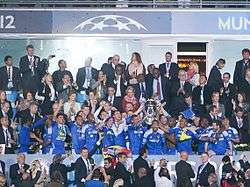
After a long-running legal battle, Bates reunited the stadium freehold with the club in 1992 by doing a deal with the banks of the property developers, who had been bankrupted by a market crash.[28] Chelsea's form in the new Premier League was unconvincing, although they did reach the 1994 FA Cup Final. The appointment of Ruud Gullit as player-manager in 1996 began an upturn in the team's fortunes. He added several top international players to the side and led the club to their first major honour since 1971, the FA Cup. Gullit was replaced by Gianluca Vialli, whose reign saw Chelsea win the League Cup, the UEFA Cup Winners' Cup and the UEFA Super Cup in 1998, and the FA Cup in 2000. They also mounted a strong title challenge in 1998–99, finishing four points behind champions Manchester United, and made their first appearance in the UEFA Champions League. Vialli was sacked in favour of Claudio Ranieri, who guided Chelsea to the 2002 FA Cup Final and Champions League qualification in 2002–03.
In July 2003, Bates sold Chelsea to Russian billionaire Roman Abramovich for £140 million.[10] Over £100 million was spent on new players, but Ranieri was unable to deliver any trophies,[29] and was replaced by José Mourinho.[30] Under Mourinho, Chelsea became the fifth English team to win back-to-back league championships since the Second World War (2004–05 and 2005–06),[31] in addition to winning an FA Cup (2007) and two League Cups (2005 and 2007). After a poor start to the 2007–2008 season, Mourinho was replaced by Avram Grant,[32] who led the club to their first UEFA Champions League final, which they lost on penalties to Manchester United.
In 2009, under caretaker manager Guus Hiddink, Chelsea won another FA Cup.[33] In 2009–10, his successor Carlo Ancelotti led them to their first Premier League and FA Cup Double, also becoming the first English top-flight club to score 100 league goals in a season since 1963.[34] In 2012, Roberto Di Matteo led Chelsea to their seventh FA Cup,[35] and their first UEFA Champions League title, beating Bayern Munich 4–3 on penalties, the first London club to win the trophy.[36] The following year the club won the UEFA Europa League,[37] making them the first club to hold two major European titles simultaneously and one of five clubs to have won the three main UEFA trophies.[38] Mourinho returned as manager in 2013 and led Chelsea to League Cup success in March 2015,[39] and the Premier League title two months later.[40] Mourinho was sacked after four months of the following season after a poor start.[41] In 2017, under new coach Antonio Conte, Chelsea won their sixth English title and the following season won their eighth FA Cup.[42] In 2018 Conte was sacked after a 5th-place finish and replaced with Maurizio Sarri,[43][44] under whom Chelsea reached the League Cup final, which they lost on penalties to Manchester City[45] and won the Europa League for a second time, beating Arsenal 4–1 in the final. Sarri then left the club to become manager of Juventus and was then replaced by former Chelsea player Frank Lampard.[46]
Stadium
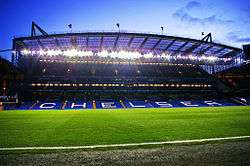
Chelsea have only had one home ground, Stamford Bridge, where they have played since the team's foundation. It was officially opened on 28 April 1877 and for the first 28 years of its existence, it was used almost exclusively by the London Athletic Club as an arena for athletics meetings and not at all for football. In 1904 the ground was acquired by businessman Gus Mears and his brother Joseph, who had also purchased nearby land (formerly a large market garden) with the aim of staging football matches on the now 12.5 acre (51,000 m²) site.[47] Stamford Bridge was designed for the Mears family by the noted football architect Archibald Leitch, who had also designed Ibrox, Craven Cottage and Hampden Park.[48] Most football clubs were founded first, and then sought grounds in which to play, but Chelsea were founded for Stamford Bridge.
Starting with an open bowl-like design and one grandstand with seating, Stamford Bridge had an original capacity of around 100,000, making it the second biggest stadium in England after Crystal Palace.[47] The early 1930s saw the construction of a terrace on the southern part of the ground with a roof that covered around one fifth of the stand. As the roof resembled that of a corrugated iron shed, the stand eventually became known as the "Shed End", although it is unknown who first coined this name. Starting in the 1960s, it became known as the home of Chelsea's most loyal and vocal supporters.[47] In 1939, another small seated stand was added, the North Stand, which remained until its demolition in 1975.[47]
In the early 1970s, the club's owners announced a modernisation of Stamford Bridge with plans for a state-of-the-art 50,000 all-seater stadium.[47] Work began in 1972 but the project was beset with problems and ultimately only the East Stand was completed; the cost brought the club close to bankruptcy, culminating in the freehold being sold to property developers. Following a long legal battle, it was not until the mid-1990s that Chelsea's future at the stadium was secured and renovation work resumed.[47] The north, west and southern parts of the ground were converted into all-seater stands and moved closer to the pitch, a process completed by 2001. The East Stand was retained from the 1970s development. In 1996, the north stand was renamed the Matthew Harding stand, after the club director and benefactor who was killed in a helicopter crash earlier that year.[49]
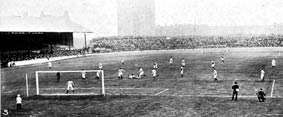
When Stamford Bridge was redeveloped in the Bates era many additional features were added to the complex including two Millennium & Copthorne hotels, apartments, bars, restaurants, the Chelsea Megastore, and an interactive visitor attraction called Chelsea World of Sport. The intention was that these facilities would provide extra revenue to support the football side of the business, but they were less successful than hoped and before the Abramovich takeover in 2003 the debt taken on to finance them was a major burden on the club. Soon after the takeover a decision was taken to drop the "Chelsea Village" brand and refocus on Chelsea as a football club. However, the stadium is sometimes still referred to as part of "Chelsea Village" or "The Village".
The Stamford Bridge freehold, the pitch, the turnstiles and Chelsea's naming rights are now owned by Chelsea Pitch Owners, a non-profit organisation in which fans are the shareholders. The CPO was created to ensure the stadium could never again be sold to developers. As a condition for using the Chelsea FC name, the club has to play its first team matches at Stamford Bridge, which means that if the club moves to a new stadium, they may have to change their name.[50] Chelsea's training ground is located in Cobham, Surrey. Chelsea moved to Cobham in 2004. Their previous training ground in Harlington was taken over by QPR in 2005.[51] The new training facilities in Cobham were completed in 2007.[52]
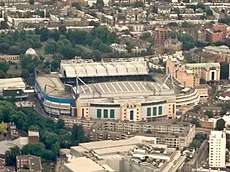
Stamford Bridge hosted the FA Cup Final from 1920 to 1922,[53] has held ten FA Cup Semi-finals (most recently in 1978), ten FA Charity Shield matches (the last in 1970), and three England international matches, the last in 1932; it was also the venue for an unofficial Victory International in 1946.[54] The 2013 UEFA Women's Champions League Final was played at Stamford Bridge as well.[55] The stadium has also been used for a variety of other sports. In October 1905 it hosted a rugby union match between the All Blacks and Middlesex,[56] and in 1914 hosted a baseball match between the touring New York Giants and the Chicago White Sox.[57] It was the venue for a boxing match between world flyweight champion Jimmy Wilde and Joe Conn in 1918.[58] The running track was used for dirt track racing between 1928 and 1932,[59] greyhound racing from 1933 to 1968, and Midget car racing in 1948.[60] In 1980, Stamford Bridge hosted the first international floodlit cricket match in the UK, between Essex and the West Indies.[61] It was also the home stadium of the London Monarchs American Football team for the 1997 season.[62]
The current club ownership have stated that a larger stadium is necessary in order for Chelsea to stay competitive with rival clubs who have significantly larger stadia, such as Arsenal and Manchester United.[63] Owing to its location next to a main road and two railway lines, fans can only enter Stamford Bridge via the Fulham Road exits, which places constraints on expansion due to health and safety regulations.[64] The club have consistently affirmed their desire to keep Chelsea at their current home,[65][66] but have nonetheless been linked with a move to various nearby sites, including the Earls Court Exhibition Centre, Battersea Power Station and the Chelsea Barracks.[67] In October 2011, a proposal from the club to buy back the freehold to the land on which Stamford Bridge sits was voted down by Chelsea Pitch Owners shareholders.[68] In May 2012, the club made a formal bid to purchase Battersea Power Station, with a view to developing the site into a new stadium,[69] but lost out to a Malaysian consortium.[70] The club subsequently announced plans to redevelop Stamford Bridge into a 60,000-seater stadium,[71] and in January 2017 these plans were approved by Hammersmith and Fulham council.[72] However, on 31 May 2018, the club released a statement saying that the new stadium project had been put on hold indefinitely, citing "the current unfavourable investment climate."[73]
Crest and colours
Crest

Chelsea have had four main crests, which all underwent minor variations. The first, adopted when the club was founded, was the image of a Chelsea pensioner, the army veterans who reside at the nearby Royal Hospital Chelsea. This contributed to the club's original "pensioner" nickname, and remained for the next half-century, though it never appeared on the shirts. When Ted Drake became Chelsea manager in 1952, he began to modernise the club. Believing the Chelsea pensioner crest to be old-fashioned, he insisted that it be replaced.[74] A stop-gap badge which comprised the initials C.F.C. was adopted for a year. In 1953, the club crest was changed to an upright blue lion looking backwards and holding a staff. It was based on elements in the coat of arms of the Metropolitan Borough of Chelsea[75] with the "lion rampant regardant" taken from the arms of then club president Viscount Chelsea and the staff from the Abbots of Westminster, former Lords of the Manor of Chelsea. It also featured three red roses, to represent England, and two footballs.[74] This was the first Chelsea crest to appear on the shirts, in the early 1960s.
In 1986, with Ken Bates now owner of the club, Chelsea's crest was changed again as part of another attempt to modernise and because the old rampant lion badge could not be trademarked.[76] The new badge featured a more naturalistic non-heraldic lion, in white and not blue, standing over the C.F.C. initials. This lasted for the next 19 years, with some modifications such as the use of different colours, including red from 1987 to 1995, and yellow from 1995 until 1999, before the white returned.[77] With the new ownership of Roman Abramovich, and the club's centenary approaching, combined with demands from fans for the popular 1950s badge to be restored, it was decided that the crest should be changed again in 2005. The new crest was officially adopted for the start of the 2005–06 season and marked a return to the older design, used from 1953 to 1986, featuring a blue heraldic lion holding a staff. For the centenary season this was accompanied by the words '100 YEARS' and 'CENTENARY 2005–2006' on the top and bottom of the crest respectively.[6]
Colours
| Wikimedia Commons has media related to Chelsea F.C. kits. |
Chelsea have always worn blue shirts, although they originally used the paler eton blue, which was taken from the racing colours of then club president, Earl Cadogan, and was worn with white shorts and dark blue or black socks.[78] The light blue shirts were replaced by a royal blue version in around 1912.[79] In the 1960s Chelsea manager Tommy Docherty changed the kit again, switching to blue shorts (which have remained ever since) and white socks, believing it made the club's colours more modern and distinctive, since no other major side used that combination; this kit was first worn during the 1964–65 season.[80] Since then Chelsea have always worn white socks with their home kit apart from a short spell from 1985 to 1992, when blue socks were reintroduced.
Chelsea's away colours are usually all yellow or all white with blue trim. More recently, the club have had a number of black or dark blue away kits which alternate every year.[81] As with most teams, they have also had some more unusual ones. At Docherty's behest, in the 1966 FA Cup semi-final they wore blue and black stripes, based on Inter Milan's kit.[82] In the mid-1970s, the away strip was a red, white and green kit inspired by the Hungarian national side of the 1950s.[83] Other memorable away kits include an all jade strip worn from 1986–89, red and white diamonds from 1990–92, graphite and tangerine from 1994–96, and luminous yellow from 2007–08.[81] The graphite and tangerine strip has appeared in lists of the worst football kits ever.[84]
Support
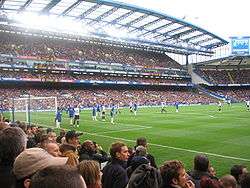
Chelsea are among the most widely supported football clubs in the world.[85][86] They have the sixth highest average all-time attendance in English football,[7] and regularly attract over 40,000 fans to Stamford Bridge; they were the seventh best-supported Premier League team in the 2013–14 season, with an average gate of 41,572.[87] Chelsea's traditional fanbase comes from all over the Greater London area including working-class parts such as Hammersmith and Battersea, wealthier areas like Chelsea and Kensington, and from the home counties. There are also numerous official supporters clubs in the United Kingdom and all over the world.[88] Between 2007 and 2012, Chelsea were ranked fourth worldwide in annual replica kit sales, with an average of 910,000.[89] As of 2018, Chelsea had 72.2 million followers on social media, the fourth highest among football clubs.[90]
At matches, Chelsea fans sing chants such as "Carefree" (to the tune of "Lord of the Dance", whose lyrics were probably written by supporter Mick Greenaway),[91][92] "Ten Men Went to Mow", "We All Follow the Chelsea" (to the tune of "Land of Hope and Glory"), "Zigga Zagga", and the celebratory "Celery". The latter is often accompanied by fans throwing celery at each other, although the vegetable was banned inside Stamford Bridge after an incident involving Arsenal midfielder Cesc Fàbregas at the 2007 League Cup Final.[93] During the 1970s and 1980s in particular, Chelsea supporters were associated with football hooliganism. The club's "football firm", originally known as the Chelsea Shed Boys, and subsequently as the Chelsea Headhunters, were nationally notorious for football violence, alongside hooligan firms from other clubs such as West Ham United's Inter City Firm and Millwall's Bushwackers, before, during and after matches.[94] The increase of hooligan incidents in the 1980s led chairman Ken Bates to propose erecting an electric fence to deter them from invading the pitch, a proposal that the Greater London Council rejected.[95]
Since the 1990s, there has been a marked decline in crowd trouble at matches, as a result of stricter policing, CCTV in grounds and the advent of all-seater stadia.[96] In 2007, the club launched the Back to the Shed campaign to improve the atmosphere at home matches, with notable success. According to Home Office statistics, 126 Chelsea fans were arrested for football-related offences during the 2009–10 season, the third highest in the division, and 27 banning orders were issued, the fifth-highest in the division.[97]
Rivalries
Chelsea have long-standing rivalries with North London clubs Arsenal and Tottenham Hotspur.[98][99] A strong rivalry with Leeds United dates back to several heated and controversial matches in the 1960s and 1970s, particularly the 1970 FA Cup Final.[100] More recently a rivalry with Liverpool has grown following repeated clashes in cup competitions.[101][102] Chelsea's fellow West London sides Brentford, Fulham and Queens Park Rangers are generally not considered major rivals, as matches have only taken place intermittently due to the clubs often being in separate divisions.[103]
A 2004 survey by Planetfootball.com found that Chelsea fans consider their main rivalries to be with (in descending order): Arsenal, Tottenham Hotspur and Manchester United. In the same survey, fans of Arsenal, Fulham, Leeds United, QPR, Tottenham, and West Ham United named Chelsea as one of their three main rivals.[104] In a 2008 poll conducted by the Football Fans Census, Chelsea fans named Liverpool, Arsenal and Manchester United as their most disliked clubs. In the same survey, "Chelsea" was the top answer to the question "Which other English club do you dislike the most?"[105] A 2012 survey, conducted among 1200 supporters of the top four league divisions across the country, found that many clubs' main rivals had changed since 2003 and reported that Chelsea fans consider Tottenham to be their main rivals, above Arsenal and Manchester United. Additionally, fans of Arsenal, Brentford, Fulham, Liverpool, Manchester United, QPR, Tottenham and West Ham identified Chelsea as one of their top three rivals.[106]
Records
Chelsea's highest appearance-maker is ex-captain Ron Harris, who played in 795 competitive games for the club between 1961 and 1980.[107] Four other players made more than 500 appearances for the club: Peter Bonetti (729; 1959–79), John Terry (717; 1998–2017), Frank Lampard (648; 2001–2014) and John Hollins (592; 1963–1975 and 1983–1984). With 103 caps (101 while at the club) for England, Lampard is Chelsea's most capped international player. Every starting player in Chelsea's 57 games of the 2013–14 season was a full international – a new club record.[108]
Lampard is Chelsea's all-time top goalscorer, having scored 211 goals in 648 games (2001–2014);[107] he passed Bobby Tambling's longstanding record of 202 in May 2013.[109] Eight other players have also scored over 100 goals for Chelsea: George Hilsdon (1906–1912), George Mills (1929–1939), Roy Bentley (1948–1956), Jimmy Greaves (1957–1961), Peter Osgood (1964–1974 and 1978–1979), Kerry Dixon (1983–1992), Didier Drogba (2004–2012 and 2014–2015), and Eden Hazard (2012–2019). Greaves holds the club record for the most goals scored in one season (43 in 1960–61).[110] While a Chelsea player, Greaves also became the youngest ever player to score 100 goals in the English top-flight, at 20 years and 290 days.[111]
Chelsea's biggest winning scoreline in a competitive match is 13–0, achieved against Jeunesse Hautcharage in the Cup Winners' Cup in 1971.[112] The club's biggest top-flight win was an 8–0 victory against Wigan Athletic in 2010, which was matched in 2012 against Aston Villa.[113] Chelsea's biggest loss was an 8–1 reverse against Wolverhampton Wanderers in 1953.[114][115] The club's 21–0 aggregate victory over Jeunesse Hautcharage in the UEFA Cup Winners' Cup in 1971 is also a record in European competition.[116] Officially, Chelsea's highest home attendance is 82,905 for a First Division match against Arsenal on 12 October 1935. However, an estimated crowd of over 100,000 attended a friendly match against Soviet team Dynamo Moscow on 13 November 1945.[117][118]
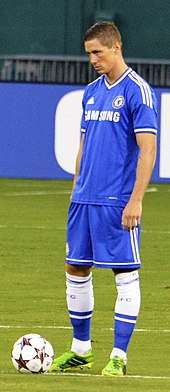
From 20 March 2004 to 26 October 2008, Chelsea went a record 86 consecutive league matches at home without defeat, beating the previous record of 63 matches unbeaten set by Liverpool between 1978 and 1980.[119][120] Chelsea hold the English record for the fewest goals conceded during a league season (15), the highest number of clean sheets overall in a Premier League season (25) (both set during the 2004–05 season),[121] and the most consecutive clean sheets from the start of a league season (6, set during the 2005–06 season).[122] Chelsea's streak of eleven consecutive away league wins, set between 5 April 2008 and 6 December 2008, is a record for the English top flight.[123] Chelsea are the only Premier League side to win their opening nine league games of the season, doing so in 2005–06.[124][125] From 2009 to 2013, Chelsea were unbeaten in a record 29 consecutive FA Cup matches (excluding penalty shoot-outs).[126]
On 25 August 1928, Chelsea, along with Arsenal, became the first club to play with shirt numbers, in their match against Swansea Town.[127] They were the first English side to travel by aeroplane to a domestic away match, when they visited Newcastle United on 19 April 1957,[128] and the first First Division side to play a match on a Sunday, when they faced Stoke City on 27 January 1974. On 26 December 1999, Chelsea became the first British side to field an entirely foreign starting line-up (no British or Irish players) in a Premier League match against Southampton.[129] In May 2007, Chelsea were the first team to win the FA Cup at the new Wembley Stadium, having also been the last to win it at the old Wembley.[130] They were the first English club to be ranked No. 1 under UEFA's five-year coefficient system in the 21st century.[131] They were the first Premier League team, and the first team in the English top flight since 1962–63, to score at least 100 goals in a single season, reaching the milestone during the 2009–10 season.[34] Chelsea are the only London club to win the UEFA Champions League.[132][133] Upon winning the 2012–13 UEFA Europa League, Chelsea became the first English club to win all four UEFA club trophies and the only club to hold the Champions League and the Europa League at the same time.[134]
Chelsea have twice broken the record for the highest transfer fee paid by a British club. Their £30.8 million purchase of Andriy Shevchenko from AC Milan in June 2006 was a British record until surpassed by the £32.5 million paid by Manchester City for Robinho in September 2008.[135][136] The club's £50 million purchase of Fernando Torres from Liverpool in January 2011[137] held the record until Ángel Di María signed for Manchester United in August 2014 for £59.7 million.[138] The club's £71 million purchase of Kepa Arrizabalaga in August 2018 remains a world record fee paid for a goalkeeper.[139]
Ownership and finances
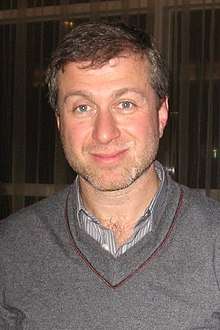
Chelsea Football Club were founded by Gus Mears in 1905. After his death in 1912, his descendants continued to own the club until 1982, when Ken Bates bought the club from Mears' great-nephew Brian Mears for £1. Bates bought a controlling stake in the club and floated Chelsea on the AIM stock exchange in March 1996.[140] In the mid-1990s Chelsea fan and businessman Matthew Harding became a director and loaned the club £26 million to build the new North Stand and invest in new players.[141]
In July 2003, Roman Abramovich purchased just over 50% of Chelsea Village plc's share capital, including Bates' 29.5% stake, for £30 million and over the following weeks bought out most of the remaining 12,000 shareholders at 35 pence per share, completing a £140 million takeover. Other shareholders at the time of the takeover included the Matthew Harding estate (21%), BSkyB (9.9%) and various anonymous offshore trusts.[142] After passing the 90% share threshold, Abramovich took the club back into private hands, delisting it from the AIM on 22 August 2003.
At the time of the Abramovich takeover, the club also had debts of around £100 million, which included a ten-year £75 million Eurobond taken out in 1997 by the Bates regime to buy the freehold of Stamford Bridge and finance the redevelopment of the stadium. The 9% interest on the loan cost the club around £7 million a year and according to Bruce Buck, Chelsea were struggling to pay an instalment due in July 2003.[143] Abramovich paid off some of this debt immediately, but the outstanding £36 million on the Eurobond was not fully repaid until 2008.[144] Since then, the club have had no external debt.[145]
Abramovich changed the ownership name to Chelsea FC plc, whose ultimate parent company is Fordstam Limited, which is controlled by him.[146] Chelsea are additionally funded by Abramovich via interest free soft loans channelled through his holding company Fordstam Limited. The loans stood at £709 million in December 2009, when they were all converted to equity by Abramovich, leaving the club themselves debt free,[147][148] although the debt remains with Fordstam.[149]
Chelsea did not turn a profit in the first nine years of Abramovich's ownership, and made record losses of £140m in June 2005.[150] In November 2012, Chelsea announced a profit of £1.4 million for the year ending 30 June 2012, the first time the club had made a profit under Abramovich's ownership.[150][151] This was followed by a loss in 2013 and then their highest ever profit of £18.4 million for the year to June 2014.[152] In 2018 Chelsea announced a record after-tax profit of £62 million.[153]
Chelsea have been described as a global brand; a 2012 report by Brand Finance ranked Chelsea fifth among football brands and valued the club's brand value at US$398 million – an increase of 27% from the previous year, also valuing them at US$10 million more than the sixth best brand, London rivals Arsenal – and gave the brand a strength rating of AA (very strong).[154][155] In 2016, Forbes magazine ranked Chelsea the seventh most valuable football club in the world, at £1.15 billion ($1.66 billion).[156] As of 2016, Chelsea are ranked eighth in the Deloitte Football Money League with an annual commercial revenue of £322.59 million.[157]
The club's recent accounting records highlight £26.6m they have lost in compensation to former head coach Antonio Conte for sacking and to pay off his backroom staff and the legal costs that followed.[158]
Sponsorship
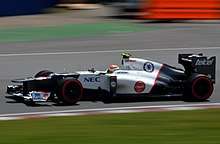
Chelsea's kit has been manufactured by Nike since July 2017. Previously, the kit was manufactured by Adidas, which was originally contracted to supply the club's kit from 2006 to 2018. The partnership was extended in October 2010 in a deal worth £160 million over eight years.[159] This deal was again extended in June 2013 in a deal worth £300 million over another ten years.[160] In May 2016, Adidas announced that by mutual agreement, the kit sponsorship would end six years early on 30 June 2017.[161] Chelsea had to pay £40m in compensation to Adidas. In October 2016, Nike was announced as the new kit sponsor, in a deal worth £900m over 15 years, until 2032.[162] Previously, the kit was manufactured by Umbro (1975–81), Le Coq Sportif (1981–86), The Chelsea Collection (1986–87), Umbro (1987–2006), and Adidas (2006–2017).
Chelsea's first shirt sponsor was Gulf Air, agreed during the 1983–84 season. The club were then sponsored by Grange Farms, Bai Lin Tea and Simod before a long-term deal was signed with Commodore International in 1989; Amiga, an offshoot of Commodore, also appeared on the shirts. Chelsea were subsequently sponsored by Coors beer (1994–97), Autoglass (1997–2001), Emirates (2001–05), Samsung Mobile (2005–08) and Samsung (2008–15).[163][164] Chelsea's current shirt sponsor is Yokohama Tyres. Worth £40 million per year, the deal is second in English football to Chevrolet's £50 million-per-year sponsorship of Manchester United.[163]
Following the introduction of sleeve sponsors in the Premier League, Chelsea had Alliance Tyres as their first sleeve sponsor in the 2017–18 season.[165] For the 2018–19 season, they have Hyundai Motor Company as the new sleeve sponsor.[166] The club also has a variety of other sponsors and official partners, which include Carabao, Delta Air Lines, Beats by Dre, Singha, EA Sports, Rexona, Hublot, Ericsson, William Hill, Levy Restaurants, Wipro, Grand Royal Whisky, Bangkok Bank, Guangzhou R&F, Mobinil, IndusInd Bank, and Ole777.[167]
Popular culture
In 1930, Chelsea featured in one of the earliest football films, The Great Game.[168] One-time Chelsea centre forward, Jack Cock, who by then was playing for Millwall, was the star of the film and several scenes were shot at Stamford Bridge, including on the pitch, the boardroom, and the dressing rooms. It included guest appearances by then-Chelsea players Andrew Wilson, George Mills, and Sam Millington.[169] Owing to the notoriety of the Chelsea Headhunters, a football firm associated with the club, Chelsea have also featured in films about football hooliganism, including 2004's The Football Factory.[170] Chelsea also appear in the Hindi film Jhoom Barabar Jhoom.[171] In April 2011, Montenegrin comedy series Nijesmo mi od juče made an episode in which Chelsea play against FK Sutjeska Nikšić for qualification of the UEFA Champions League.[172]
Up until the 1950s, the club had a long-running association with the music halls; their underachievement often provided material for comedians such as George Robey.[173] It culminated in comedian Norman Long's release of a comic song in 1933, ironically titled "On the Day That Chelsea Went and Won the Cup", the lyrics of which describe a series of bizarre and improbable occurrences on the hypothetical day when Chelsea finally won a trophy.[14] In Alfred Hitchcock's 1935 film The 39 Steps, Mr Memory claims that Chelsea last won the Cup in 63 BC, "in the presence of the Emperor Nero."[174] Scenes in a 1980 episode of Minder were filmed during a real match at Stamford Bridge between Chelsea and Preston North End with Terry McCann (played by Dennis Waterman) standing on the terraces.[175]
The song "Blue is the Colour" was released as a single in the build-up to the 1972 League Cup Final, with all members of Chelsea's first team squad singing; it reached number five in the UK Singles Chart.[176] The song has since been adopted as an anthem by a number of other sports teams around the world, including the Vancouver Whitecaps (as "White is the Colour")[177] and the Saskatchewan Roughriders (as "Green is the Colour").[178] In the build-up to the 1997 FA Cup Final, the song "Blue Day", performed by Suggs and members of the Chelsea squad, reached number 22 in the UK charts.[179]
Chelsea Women
Chelsea also operate a women's football team, Chelsea Football Club Women, formerly known as Chelsea Ladies. They have been affiliated to the men's team since 2004[180] and are part of the club's Community Development programme. They play their home games at Kingsmeadow, the home ground of the EFL League One club AFC Wimbledon. The club were promoted to the Premier Division for the first time in 2005 as Southern Division champions and won the Surrey County Cup nine times between 2003 and 2013.[181] In 2010 Chelsea Ladies were one of the eight founder members of the FA Women's Super League.[182] In 2015, Chelsea Ladies won the FA Women's Cup for the first time, beating Notts County Ladies at Wembley Stadium,[183] and a month later clinched their first FA WSL title to complete a league and cup double.[184] In 2018 they won a second league and FA Cup double.[185] John Terry, former captain of the Chelsea men's team, is the President of Chelsea Women.[186]
Players
Current squad
Note: Flags indicate national team as defined under FIFA eligibility rules. Players may hold more than one non-FIFA nationality.
|
|
Out on loan
Note: Flags indicate national team as defined under FIFA eligibility rules. Players may hold more than one non-FIFA nationality.
|
|
Under-23s and Academy
Player of the Year
|
|
|
|
Source: Chelsea F.C.
Notable managers
The following managers won at least one trophy when in charge of Chelsea:
| Name | Period | Trophies |
|---|---|---|
| 1952–1961 | First Division Championship, Charity Shield | |
| 1962–1967 | League Cup | |
| 1967–1974 | FA Cup, UEFA Cup Winners' Cup | |
| 1981–1985 | Second Division Championship | |
| 1985–1988 | Full Members Cup | |
| 1988–1991 | Second Division Championship, Full Members Cup | |
| 1996–1998 | FA Cup | |
| 1998–2000 | FA Cup, League Cup, Charity Shield, UEFA Cup Winners' Cup, UEFA Super Cup | |
| 2004–2007 2013–2015 |
3 Premier Leagues, 3 League Cups, FA Cup, Community Shield | |
| 2009 2015–2016[nb 1] |
FA Cup | |
| 2009–2011 | Premier League, FA Cup, Community Shield | |
| 2012[nb 2] | FA Cup, UEFA Champions League | |
| 2012–2013[nb 3] | UEFA Europa League | |
| 2016–2018 | Premier League, FA Cup | |
| 2018–2019 | UEFA Europa League | |
Management team
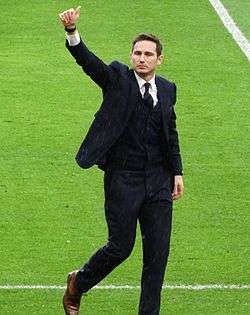
| Position | Staff |
|---|---|
| Head coach | |
| Assistant head coach | |
| Assistant coaches | |
| Goalkeeper coaches | |
| Fitness coaches | |
| Technical and performance advisor | |
| Medical director | |
| Loan technical coaches | |
| Loan goalkeeper coach | |
| Head of international scouting | |
| Technical mentor | |
| Head of youth development | |
| Development squad manager | |
| Under-18's manager |
Source: Chelsea F.C.
Club personnel
Chelsea FC plc is the company which owns Chelsea Football Club. The ultimate parent company of Chelsea FC plc is Fordstam Limited and the ultimate controlling party of Fordstam Limited is Roman Abramovich.[196]
Chelsea Ltd.
- Owner: Roman Abramovich
Chelsea F.C. plc Board[196]
Executive Board[196]
- Chief Executive: Guy Laurence
- Club Secretary: David Barnard
- Chairman: Bruce Buck
- Directors: Eugene Tenenbaum and Marina Granovskaia
- Football Club Board: David Barnard, Bruce Buck, Marina Granovskaia, Guy Laurence and Eugene Tenenbaum
Life President
- Lord Attenborough (1923–2014)
Vice-Presidents
- Peter Digby
- Sir Peter Harrison
- Joe Hemani
- Anthony Reeves
- Alan Spence
Club Ambassadors[199]
- Carlo Cudicini
- Tore André Flo
- Paulo Ferreira
- Eddie Newton
Source: Chelsea F.C.
Controversy
Sexual abuse
In August 2019, Chelsea's board apologised "unreservedly" after a report found that during the 1970s the club's chief scout, Eddie Heath, groomed and abused young boys aged between 10 and 17. The report, which was led by Charles Geekie QC, concluded that Heath was a "prolific and manipulative sexual abuser" and had been able to operate "unchallenged". The report was also heavily critical of the club's former assistant manager Dario Gradi, who was accused of failing to tell more senior club staff about an allegation regarding the sexual conduct of Heath which had been brought to him by the father of a young player.
In light of the report, Chelsea announced that it was committed to assessing compensation claims for victims.[200]
Racial abuse
In May 2018, the club appointed Barnardo's to oversee an independent investigation into the allegations of racism. The complaints were initially brought by three former youth-team footballers who claimed that Gwyn Williams and Graham Rix subjected young black players to explicit racial abuse, during their time at the club in the 1990s.[201]
In August 2019, Barnardo's published the findings of its review. The report concluded that "black players were subjected to a daily tirade of racial abuse".[200] Following the publication of the report, the club issued a statement in which it acknowledged that "Barnardo's found that there is overwhelming information indicating that a member of staff at the club during the 1980s and 1990s subjected young players to bullying and racially abuse behaviour".[202]
Honours
Upon winning the 2012–13 UEFA Europa League, Chelsea became the fourth club in history to have won the "European Treble" of European Cup/UEFA Champions League, UEFA Cup/UEFA Europa League, and European Cup Winners' Cup/UEFA Cup Winners' Cup after Juventus, Ajax and Bayern Munich. Chelsea are the first English club to have won all three major UEFA trophies.[203]
National competitions
League titles
- Winners (6): 1954–55, 2004–05, 2005–06, 2009–10, 2014–15, 2016–17
- Second Division[nb 4]
- Winners (2): 1983–84, 1988–89
Cups
.jpg)
- Winners (8): 1969–70, 1996–97, 1999–2000, 2006–07, 2008–09, 2009–10, 2011–12, 2017–18
- Winners (5): 1964–65, 1997–98, 2004–05, 2006–07, 2014–15
- FA Community Shield[nb 5]
- Winners (4): 1955, 2000, 2005, 2009
- Full Members' Cup
- Winners (2): 1985–86, 1989–90
European competitions
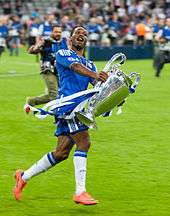
- Winners: 2011–12
- Winners (2): 2012–13, 2018–19
- Winners (2): 1970–71, 1997–98
- UEFA Super Cup
- Winners: 1998
Doubles
- 1997–98: League Cup and European Cup Winners' Cup
- 2004–05: League and League Cup
- 2006–07: FA Cup and League Cup
- 2009–10: League and FA Cup
- 2011–12: FA Cup and UEFA Champions League
- 2014–15: League and League Cup
UEFA club coefficient ranking
- As of 2 March 2020[204]
| Rank | Team | Points |
|---|---|---|
| 13 | 85.000 | |
| 14 | 83.000 | |
| 15 | 79.000 | |
| 16 | 77.000 | |
| 17 | 77.000 |
Notes
- Includes Caretaker manager
- Won as Interim first team coach
- Includes Interim manager
- Upon its formation in 1992, the Premier League became the top tier of English football; the First and Second Divisions then became the second and third tiers, respectively. The First Division is now known as the Football League Championship and the Second Division is now known as Football League One.
- The trophy was known as the Charity Shield until 2002, and as the Community Shield ever since.
Footnotes
- "Chelsea's first cup final – a century ago". Chelsea FC. 23 April 2015. Archived from the original on 26 August 2016. Retrieved 25 July 2016.
- "Team History – Introduction". chelseafc.com. Chelsea FC. Archived from the original on 27 May 2011. Retrieved 11 May 2011.
- "Premier League Handbook 2019–20". Premier League. 2 August 2019. Retrieved 8 August 2019.
- "General Club Information". chelseafc.com. Chelsea FC. Retrieved 13 August 2015.
- "Trophy Cabinet". chelseafc.com. Chelsea FC. Retrieved 23 May 2018.
- "Chelsea centenary crest unveiled". BBC Sport. 12 November 2004. Retrieved 2 January 2007.
- "All Time League Attendance Records". nufc.com. 22 September 2015. Archived from the original on 6 April 2016. Retrieved 6 April 2016. Please note, pre-war figures come from unreliable sources.
- Ozanian, Mike. "The World's Most Valuable Soccer Teams 2018". Forbes. Retrieved 12 June 2018.
- "Deloitte Football Money League 2018". Deloitte. 23 January 2018. Retrieved 23 January 2018.
- "Russian businessman buys Chelsea". BBC Sport. 2 July 2003. Retrieved 11 February 2007.
- Glanvill, Rick (2006). Chelsea FC: The Official Biography. p. 55.
- "The Birth of a Club". Chelsea FC. 30 September 2004. Retrieved 16 December 2015.
- "Team History – 1905–29". chelseafc.com. Chelsea FC. Archived from the original on 18 July 2011. Retrieved 23 April 2014.
- Glanville, Brian (10 January 2004). "Little sign of change for Chelsea and their impossible dreams". The Times. UK. Retrieved 15 March 2009. (registration required)
- http://www.european-football-statistics.co.uk/attn.htm
- "Historical attendances". European Football Statistics. Archived from the original on 4 October 2011. Retrieved 18 August 2011.
- "Historical attendances". European Football Statistics. Archived from the original on 4 October 2011. Retrieved 18 August 2011.
- "Historical attendances". European Football Statistics. Archived from the original on 4 October 2011. Retrieved 18 August 2011.
- "Historical attendances". European Football Statistics. Archived from the original on 4 October 2011. Retrieved 18 August 2011.
- "Historical attendances". European Football Statistics. Archived from the original on 4 October 2011. Retrieved 18 August 2011.
- "Historical attendances". European Football Statistics. Archived from the original on 18 August 2012. Retrieved 18 August 2011.
- "Between the Wars – Big Names and Big Crowds". chelseafc.com. Chelsea FC. Archived from the original on 20 July 2012. Retrieved 7 May 2012.
- Glanville, Brian (27 April 2005). "The great Chelsea surrender". The Times. UK. Retrieved 29 December 2006.
- Glanvill, Rick (2006). Chelsea FC: The Official Biography – The Definitive Story of the First 100 Years. Headline Book Publishing Ltd. p. 196. ISBN 978-0-7553-1466-9.
- Glanvill, Rick (2006). Chelsea FC: The Official Biography. pp. 84–87.
- Glanvill, Rick (2006). Chelsea FC: The Official Biography. pp. 143–157.
- Glanvill, Rick (2006). Chelsea FC: The Official Biography. pp. 89–90.
- Glanvill, Rick (2006). Chelsea FC: The Official Biography. pp. 90–91.
- "Chelsea sack Ranieri". BBC Sport. 1 June 2004. Retrieved 20 May 2012.
- "Chelsea appoint Mourinho". BBC Sport. 2 June 2004. Retrieved 20 May 2012.
- Barlow, Matt (12 March 2006). "Terry Eyes Back-to-Back Titles". Sporting Life. Archived from the original on 3 June 2012. Retrieved 22 January 2007.
- "Chelsea name Grant as new manager". BBC Sport. 20 September 2007. Retrieved 21 September 2007.
- "Chelsea 2–1 Everton". BBC Sport. 30 May 2009. Retrieved 1 June 2009.
- "Chelsea 8–0 Wigan". BBC Sport. 9 May 2010. Retrieved 16 May 2010.
- McNulty, Phil (5 May 2012). "Chelsea 2–1 Liverpool". BBC Sport. Retrieved 20 May 2012.
- McNulty, Phil (19 May 2012). "Bayern Munich 1–1 Chelsea (aet, 4–3 pens)". BBC Sport. Retrieved 20 May 2012.
- "Benfica 1–2 Chelsea". BBC Sport. 15 May 2013. Retrieved 15 May 2013.
- "Chelsea claim last-gasp Europa League triumph". Agence France-Presse. 15 May 2013. Archived from the original on 27 February 2014. Retrieved 3 August 2013.
- "Chelsea 2–0 Tottenham Hotspur". BBC Sport. 1 March 2015. Retrieved 13 April 2015.
- McNulty, Phil (3 May 2015). "Chelsea 1–0 Crystal Palace". BBC Sport. Retrieved 4 May 2015.
- "Jose Mourinho: Chelsea sack boss after Premier League slump". BBC Sport. 17 December 2015.
- "Chelsea crowned Premier League champions after win at West Brom – as it happened". The Guardian. 12 May 2017.
- "Conte sacked as Chelsea boss". BBC. Retrieved 17 June 2019.
- "Maurizio Sarri appointed Chelsea boss, replacing Antonio Conte". Sky Sports. Retrieved 17 June 2019.
- "Match report: Carabao Cup Final". efl.com. English Football League. Retrieved 17 June 2019.
- "Frank Lampard confirmed as new Chelsea boss". Chelsea FC. 4 July 2019. Retrieved 18 July 2019.
- "Stadium History – Introduction". chelseafc.com. Chelsea FC. Archived from the original on 12 May 2012. Retrieved 20 May 2012.
- Glanvill, Rick (2006). Chelsea FC: The Official Biography. pp. 69–71.
- "Matthew Harding Remembered". chelseafc.com. Retrieved 1 July 2019.
- Glanvill, Rick (2006). Chelsea FC: The Official Biography. pp. 91–92.
- Veysey, Wayne (24 May 2005). "QPR take over Chelsea training ground". London Evening Standard. Archived from the original on 25 October 2012. Retrieved 24 June 2009.
- "Chelsea's new training ground for the future". BBC London. 5 July 2007. Retrieved 24 June 2009.
- "Cup Final Statistics". The Football Association. Archived from the original on 16 May 2012. Retrieved 18 February 2011.
- "England's Matches: Unofficial". Englandfootballonline. Archived from the original on 22 January 2011. Retrieved 18 February 2011.
- "2013 final: Stamford Bridge". UEFA. Retrieved 11 March 2014.
- "All Blacks". Rugbyfootballhistory.com. Retrieved 18 February 2011.
- "Countdown to SABR Day 2011". BaseballGB.co.uk. Retrieved 18 February 2011.
- "Jimmy Wilde: The Original Explosive Thin Man". Cyberboxingzone.com. Retrieved 18 February 2011.
- "Stamford Bridge Speedway". guskuhn.net. Retrieved 18 February 2011.
- "U.S. Invades England 1948". speedcarworld.com. Archived from the original on 25 March 2012. Retrieved 19 February 2011.
- "Twenty20 before Twenty20". spincricket.com. Archived from the original on 11 January 2012. Retrieved 18 February 2011.
- "London Monarchs". Britballnow.co.uk. Retrieved 19 February 2011.
- "Chelsea chief: We will drop out of Europe's elite without new stadium". BBC. 25 April 2012. Retrieved 6 May 2012.
- Glanvill, Rick (2006). Chelsea FC: The Official Biography. p. 76.
- "Kenyon confirms Blues will stay at Stamford Bridge". RTÉ Sport. 12 April 2006. Archived from the original on 15 December 2007. Retrieved 1 January 2007.
- "Observer Stadium Story Denied". chelseafc.com. Chelsea FC. 9 November 2008. Archived from the original on 23 April 2014. Retrieved 23 April 2014.
- "Chelsea plan Bridge redevelopment". BBC Sport. 20 January 2006. Retrieved 1 January 2007.
- "Chelsea FC lose fan vote on stadium". BBC. 27 October 2011. Retrieved 11 March 2012.
- "Chelsea bid to buy Battersea power station in £1bn stadium plan". The Guardian. UK. 4 May 2012. Retrieved 6 May 2012.
- "Chelsea's Battersea hopes end as Malaysian consortium completes deal". The Guardian. UK. 5 July 2012. Retrieved 10 November 2012.
- "Stamford Bridge: 'Slinky' or Bird's Nest? Chelsea unveil new £500m stadium". The Independent. UK. 3 December 2015. Retrieved 3 December 2015.
- "'Chelsea's new £500m stadium will be one of world's best arenas'". London Evening Standard. 12 January 2017.
- "Stadium plans on hold". chelseafc.com. Chelsea FC.
- Glanvill, Rick (2006). Chelsea FC: The Official Biography. p. 42.
- "Chelsea Metropolitan Borough Council". Civic Heraldry of England and Wales. Retrieved 21 January 2007.
- "1980s Summary". Chelsea FC. Retrieved 3 December 2015.
- Moor, Dave. "Historical Kits – Chelsea". Historical Kits. Retrieved 28 September 2011.
- "Chelsea – Historical Football Kits". Historical Kits. Retrieved 26 June 2012.
- Glanvill, Rick (2006). Chelsea Football Club: The Official History in Pictures. ISBN 978-0-7553-1467-6. p. 212
- Mears, Brian (2002). Chelsea: Football Under the Blue Flag. Mainstream Sport. p. 42. ISBN 978-1-84018-658-1.
- "Chelsea Change Kits". Historical Kits. Retrieved 7 December 2015.
- Mears, Brian (2002). Chelsea: Football Under the Blue Flag. p. 58.
- Batty, Clive (2007). Kings of the King's Road: The Great Chelsea Team of the 60s & 70s. Vision Sports Publishing. p. 244. ISBN 978-1-905326-22-8.
- "Eyes wide shut". The Observer. 12 August 2007. Retrieved 7 December 2015.
- Anderson, Jamie. "Chelsea are a more universally loved club! Blues chief lauds 400million fan base". Daily Express. London.
- "The world's most popular football club revealed: Man United, Liverpool F.C., Arsenal F.C., Barca, Real or Chelsea?". talkSPORT. 13 October 2011.
- "Attendances (at home)". Soccerstats.com. Retrieved 21 May 2017.
- "Supporters Clubs Map". chelseafc.com. Archived from the original on 23 March 2014. Retrieved 23 March 2014.
- "EXCLUSIVE: Manchester United and Real Madrid top global shirt sale charts". Sporting Intelligence. 8 October 2012. Retrieved 8 October 2012.
- "The 20 most popular rich-list football teams on social media". Business Insider. Retrieved 23 June 2019.
- Glanvill, Rick (2006). Chelsea FC: The Official Biography. p. 150.
- ""Carefree" audio sample". Fanchants.com. Retrieved 3 September 2011.
- Murray, Scott (17 April 2002). "Fans sent spinning after tossing salad". The Guardian. Retrieved 1 January 2007.
- "Making a new start". BBC News. 2 May 2002. Retrieved 21 January 2007.
- "Bates: Chelsea's driving force". BBC Sport. 2 July 2003. Retrieved 21 January 2007.
- "Soccer hooliganism: Made in England, but big abroad". BBC News. 2 June 1998. Retrieved 1 January 2007.
- "Statistics on football-related arrests and banning orders". Home Office. November 2010. Archived from the original (PDF) on 17 March 2011. Retrieved 14 May 2011.
- Glanvill, Rick (2006). Chelsea FC: The Official Biography. pp. 312–318.
- "A brief history of the Arsenal-Chelsea rivalry and why it matters". The Guardian. 22 April 2015. Retrieved 7 December 2015.
- Glanvill, Rick (2006). Chelsea FC: The Official Biography. pp. 321–325.
- "Six very modern football rivalries". TalkSport. 19 May 2011. Archived from the original on 25 May 2013. Retrieved 23 May 2011.
- "A brief guide to Chelsea's rivalry with Liverpool". The Guardian. 29 October 2015. Retrieved 4 December 2015.
- Glanvill, Rick (2006). Chelsea FC: The Official Biography. p. 311.
- "Football Rivalries: The Complete Results". Planetfootball.com. Retrieved 2 January 2007.
- "The London Football Report 2008" (PDF). Football Fans Census. Archived from the original (PDF) on 1 March 2014. Retrieved 22 May 2018.
- "Football Rivalries: The Survey". The Daisy Cutter. 14 September 2012. Retrieved 22 May 2018.
- For the appearance and goalscoring records of all Chelsea players, see Glanvill, Rick (2006). Chelsea FC: The Official Biography. pp. 399–410.
- "Pre-Match Briefing: Burnley v Chelsea – part one". Chelsea FC. Retrieved 18 August 2014.
- "Chelsea's Frank Lampard given golden boot by Bobby Tambling". BBC. 19 May 2013. Retrieved 7 September 2013.
- "Chelsea Legends". Chelsea News. 17 February 2009. Retrieved 11 August 2014.
- "Jimmy Greaves". www.chelseafc.com. Archived from the original on 12 August 2014. Retrieved 11 August 2014.
- "Words on Winning: 21–0". chelseafc.com. Chelsea FC. Archived from the original on 23 April 2014. Retrieved 23 April 2014.
- "Chelsea v Wigan match report". chelseafc.com. Chelsea FC. Archived from the original on 5 June 2014. Retrieved 23 April 2014.
- "Chelsea FC". UEFA.com. Union of European Football Associations. Retrieved 15 January 2012.
- Dutton, Paul. "Ask Statsman 37". Chelsea FC. Archived from the original on 21 November 2013. Retrieved 23 April 2014.
- "Cup Winners' Cup Trivia". Rec.Sport.Soccer Statistics Foundation. Retrieved 21 January 2007.
- "Team History – 1940s". chelseafc.com. Chelsea FC. Archived from the original on 13 July 2011. Retrieved 23 April 2014.
- Viner, Brian (29 October 2005). "Brian Viner: Diamond days of side who brought touch of glamour to post-war Britain". The Independent. Independent Print Limited. Archived from the original on 2 March 2014. Retrieved 20 May 2012.
- "Chelsea 3–2 Birmingham". BBC Sport. 12 August 2007. Retrieved 9 October 2007.
- "Chelsea 0–1 Liverpool". BBC Sport. 26 October 2008. Retrieved 26 October 2008.
- "Mourinho proud of battling finish". BBC Sport. 13 May 2005. Retrieved 29 August 2010.
- "Charlton 0–2 Chelsea". BBC Sport. 17 September 2005. Retrieved 12 November 2007.
- "Chelsea in eleven heaven". Premier League. 8 December 2008. Archived from the original on 19 December 2008. Retrieved 18 January 2009.
- Diamond, Harry (19 September 2019). "Six best ever starts to a Premier League season". The Football Faithful. Retrieved 28 November 2019.
- "Premier League stats: Manchester United end Liverpool's winning run". BBC. 21 October 2019. Retrieved 28 November 2019.
- "Chelsea 1-0 Man Utd". BBC. 1 April 2013. Retrieved 15 November 2019.
- "Shirt Numbers". England Football Online. Retrieved 1 October 2006.
- Glanvill, Rick (2006). Chelsea FC: The Official Biography. p. 96.
- Bradley, Mark (27 December 1999). "Southampton 1 Chelsea 2". Sporting Life. Archived from the original on 3 June 2012. Retrieved 27 January 2007.
- Mitchell, Kevin (20 May 2007). "Something old, new and Blue". The Observer. Retrieved 14 July 2011.
- Kassies, Bert. "UEFA Team Ranking 2008". UEFA European Cup Football: Results and Qualification. Retrieved 2 June 2008.
- "Chelsea win breaks London duck". Union of European Football Associations. 20 May 2012. Retrieved 20 May 2012.
- "Chelsea etch new name on trophy". Union of European Football Associations. 19 May 2012. Retrieved 20 May 2012.
- "Chelsea first team to hold Champions, Europa League titles". Vanguard. 15 May 2013.
- "Chelsea land Shevchenko with £30.8m record deal". The Independent. 1 June 2006. Retrieved 15 November 2019.
- "Man City beat Chelsea to Robinho". BBC. 5 January 2012. Retrieved 15 November 2019.
- "Torres makes record move from Liverpool to Chelsea". BBC. 31 January 2011. Retrieved 12 March 2012.
- "Transfer news: Manchester United sign Angel di Maria from Real Madrid". Sky Sports.
- "Kepa Arrizabalaga: Chelsea sign Athletic Bilbao goalkeeper in world record deal". BBC. 9 August 2018. Retrieved 15 November 2019.
- "UK Football Clubs on the UK Stock Markets". Football Economy. Retrieved 26 June 2012.
- "The battle of Stamford Bridge". The Independent. 11 November 1995. Retrieved 20 July 2019.
- "Bates sells off Chelsea to a Russian billionaire". The Daily Telegraph. 7 February 2003. Retrieved 27 June 2012.
- "Roman Abramovich clears Chelsea debt". The Daily Telegraph. 22 December 2007. Retrieved 30 June 2019.
- "Chelsea tycoon to clear club's debt". BBC. 28 July 2003. Retrieved 26 June 2012.
- "Chelsea and United debts at record £1.5bn". The Guardian. 20 May 2008. Retrieved 27 June 2012.
- "Club Information". Chelsea FC. Archived from the original on 2 July 2012. Retrieved 26 June 2012.
- "Roman Abramovich turns £340m of debt into equity as Chelsea loss falls". The Guardian. 30 December 2009. Retrieved 27 June 2012.
- "Statement on Club Finance". Chelsea FC. Archived from the original on 23 April 2014. Retrieved 23 April 2014.
- "Roman Abramovich still owed £726m under complex Chelsea structure". The Guardian. 19 May 2010. Retrieved 27 June 2012.
- "Chelsea FC record first Abramovich-era profit". BBC. 9 November 2012. Retrieved 25 February 2015.
- "CHELSEA FC ANNOUNCES ANNUAL PROFIT". Chelsea FC. 9 November 2012. Archived from the original on 11 November 2012. Retrieved 9 November 2012.
- "Chelsea FC reports a record £18m in annual profit". BBC. 14 November 2014. Retrieved 14 November 2014.
- "Chelsea FC financial results show record revenues". Chelseafc.com. 31 December 2018. Retrieved 20 July 2019.
- "Top 20 most Valuable Football Club Brands" (PDF). Brand Finance. May 2012. Retrieved 26 June 2012.
- "Top 30 Football Club Brands" (PDF). Brand Finance. September 2011. Retrieved 4 October 2011.
- Ozanian, Mike (6 June 2017). "The World's Most Valuable Soccer Teams 2017". Forbes. Retrieved 11 November 2017.
- "Chelsea – Deloitte Football Money League". Deloitte. Retrieved 21 January 2016.
- "Antonio Conte sacking cost Chelsea £26.6m, accounts show". Sky Sports. Retrieved 7 January 2019.
- "Chelsea manager Carlo Ancelotti puts his faith in elder statesman Didier Drogba". The Daily Telegraph. 22 October 2010. Retrieved 27 June 2012.
- "Chelsea and Adidas Announce Extension of Global Partnership". Chelsea FC. 22 June 2013. Archived from the original on 24 June 2013. Retrieved 22 June 2013.
- "Adidas ends Chelsea sponsorship six years early". BBC. 11 May 2016. Retrieved 28 December 2016.
- "Chelsea confirm kit deal with Nike worth £60m a season until 2032". The Guardian. 13 October 2016. Retrieved 28 December 2016.
- "Chelsea sign £40m-per-year shirt deal with Japanese tyre company". BBC Sport. 26 February 2015. Retrieved 27 February 2015.
- O'Connor, Ashling (2 May 2005). "Clubs to cash in on mobile advertising". The Times. UK. Retrieved 21 January 2010.
- "Alliance Tyres to appear on 2017/18 sleeves". chelseafc.com. 22 July 2017. Retrieved 22 July 2017.
- "Chelsea and Hyundai Begin New Partnership". chelseafc.com. 11 June 2018. Retrieved 11 June 2018.
- "Sponsors and Partners". chelseafc.com. Chelsea FC. Retrieved 4 November 2014.
- "The Great Game". Internet Movie Database. Retrieved 1 October 2007.
- Glanvill, Rick (2006). Chelsea FC: The Official Biography. pp. 120–121.
- Hawkes, Steve (10 May 2004). "Football firms hit the film circuit". BBC Sport. Retrieved 25 January 2007.
- "Chelsea teams up with Yash Raj Films". DNA India. 25 September 2006. Archived from the original on 30 September 2007. Retrieved 1 January 2007.
- "Nijesmo mi od Juce – Novosti – Epizode – Chelsea u "gledajte onlajn" sekciji" (in Montenegrin). nijesmomiodjuce.com. Archived from the original on 30 August 2013. Retrieved 23 April 2014.
- Murray, Scott (30 September 2002). "Di Canio has last laugh at Chelsea comedy store". The Guardian. Retrieved 14 July 2011.
- "The 39 Steps". Internet Movie Database. Retrieved 5 May 2014.
- "All About Scoring, Innit?". Minder.org. Retrieved 8 September 2015.
- "Blue Is The Colour". Official Charts Company. Retrieved 21 January 2007.
- "Caps' 'Proclaim' season opener". Vancouver Courier. Archived from the original on 3 January 2008. Retrieved 21 January 2007.
- Hunt, Stephen (26 November 2009). "Riders fans enjoy musical edge". Calgary Herald. Archived from the original on 5 May 2014. Retrieved 5 May 2014.
- "Blue Day". Official Charts Company. Retrieved 11 September 2016.
- "Chelsea Moving on Up". FemaleSoccer.net. Retrieved 20 February 2011.
- "Womens Cup Previous Winners". surreyfa.com. Archived from the original on 5 September 2014. Retrieved 11 March 2014.
- "Eight teams successful in Women's Super League bid". London: fcbusiness.co.uk. 24 March 2010. Archived from the original on 25 January 2011. Retrieved 20 February 2011.
- "Chelsea lift FA Cup in front of record crowd". shekicks.net. 2 August 2015. Archived from the original on 8 December 2015. Retrieved 2 August 2015.
- "Chelsea Ladies: How Women's Super League title was won". UK: BBC. 5 October 2015. Retrieved 30 November 2015.
- "Chelsea Ladies win Super League title to complete double and give Katie Chapman perfect farewell". The Daily Telegraph. UK. 15 May 2018. Retrieved 6 July 2019.
- Leighton, Tony (18 October 2009). "John Terry digs deep to rescue Chelsea Ladies after funding cuts". The Guardian. UK. Retrieved 20 February 2011.
- "Teams: Men". Chelsea F.C. Retrieved 3 August 2019.
- "Chelsea 2019/20 squad numbers announced". Chelsea F.C. 2 August 2019. Retrieved 3 August 2019.
- "2019/20 Premier League squad numbers". www.premierleague.com. Retrieved 5 September 2019.
- "Lampard on Kante fitness, new role for Jorginho and Southampton's threat". Chelsea F.C. 4 October 2019. Retrieved 4 October 2019.
- "Chelsea v Crystal Palace, 2019/20 | Premier League". Premier League. 9 November 2019. Retrieved 14 November 2019.
- "Cesar Azpilicueta on result and season that sealed third and his Eden Hazard hope". Chelsea F.C. 13 May 2019. Retrieved 19 July 2019.
- "Petr Cech appointed Technical and Performance Advisor". Chelsea F.C. 21 June 2019. Retrieved 23 February 2020.
- "Carlo Cudicini takes on role coaching Chelsea loan players". Chelsea F.C. 2 August 2019. Retrieved 21 August 2019.
- "Claude Makelele returns to Chelsea in a new coaching role". Chelsea F.C. 2 August 2019. Retrieved 21 August 2019.
- "Club Personnel". Chelsea FC. 18 July 2018.
- "Club Personnel". Chelsea FC. 18 July 2018.
- Fifield, Dominic (14 June 2013). "Chelsea give formal role to Abramovich aide Marina Granovskaia". Daily Mail. Retrieved 15 June 2013.
- "Club Ambassadors". Chelsea FC. 18 July 2018.
- "Chelsea apology over ex-chief scout Eddie Heath's 'unchallenged' sex abuse". 6 August 2019. Retrieved 6 August 2019.
- Taylor, Daniel (9 May 2018). "Chelsea bring in Barnardo's to investigate claims of racism by coaches". The Guardian. ISSN 0261-3077. Retrieved 6 August 2019.
- Wilson, Jeremy (6 August 2019). "Dario Gradi accused of failing to prevent abuse by former Chelsea coach and serial sexual offender Eddie Heath". The Daily Telegraph. ISSN 0307-1235. Retrieved 6 August 2019.
- "Chelsea join illustrious trio". UEFA. 15 May 2013.
- UEFA.com. "Member associations – UEFA Coefficients – Club coefficients". UEFA.
See also
- List of Chelsea F.C. records and statistics
- List of Chelsea F.C. players
- List of Chelsea F.C. seasons
- List of Chelsea F.C. managers
- Arsenal F.C.–Chelsea F.C. rivalry
- Chelsea F.C.–Tottenham Hotspur F.C. rivalry
- London derbies
References
- Batty, Clive (2004). Kings of the King's Road: The Great Chelsea Team of the 60s and 70s. Vision Sports Publishing Ltd. ISBN 978-0-9546428-1-5.
- Batty, Clive (2005). A Serious Case of the Blues: Chelsea in the 80s. Vision Sports Publishing Ltd. ISBN 978-1-905326-02-0.
- Glanvill, Rick (2006). Chelsea FC: The Official Biography – The Definitive Story of the First 100 Years. Headline Book Publishing Ltd. ISBN 978-0-7553-1466-9.
- Hadgraft, Rob (2004). Chelsea: Champions of England 1954–55. Desert Island Books Limited. ISBN 978-1-874287-77-3.
- Harris, Harry (2005). Chelsea's Century. Blake Publishing. ISBN 978-1-84454-110-2.
- Ingledew, John (2006). And Now Are You Going to Believe Us: Twenty-five Years Behind the Scenes at Chelsea FC. John Blake Publishing Ltd. ISBN 978-1-84454-247-5.
- Matthews, Tony (2005). Who's Who of Chelsea. Mainstream Publishing. ISBN 978-1-84596-010-0.
- Mears, Brian (2004). Chelsea: A 100-year History. Mainstream Sport. ISBN 978-1-84018-823-3.
- Mears, Brian (2002). Chelsea: Football Under the Blue Flag. Mainstream Sport. ISBN 978-1-84018-658-1.
External links
| Wikimedia Commons has media related to Chelsea F.C.. |
- Official website
- Chelsea F.C. at Premier League
- Chelsea F.C. on BBC Sport: Club news – Recent results and fixtures